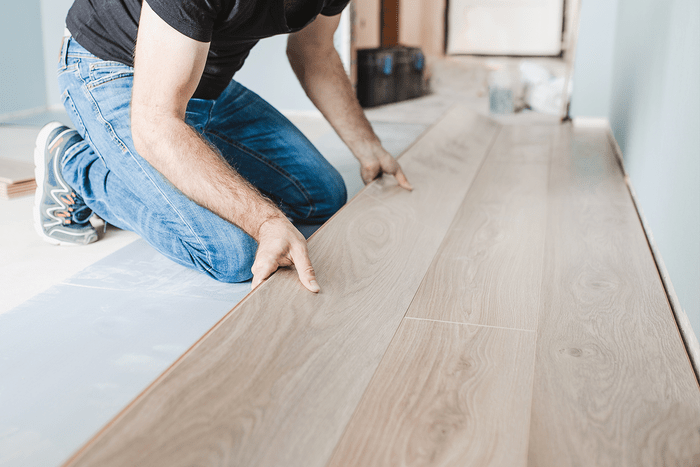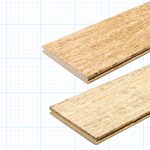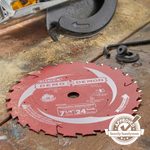What Is Rigid Core Flooring and Should You Get It?

Rigid core flooring is the modern version of luxury vinyl planks (LVP). It's attractive, long-lasting and easy to install, so there's a lot to like.
I wish I had known about rigid core flooring before redoing my kitchen floor. After laying two-inch oak hardwood flooring, a painstaking task that required a lot of nailing, the refrigerator icemaker line started leaking. Water seeped between the subfloor and the floor covering, resulting in severe cupping. So I had to replace the floor (after fixing the leak, of course).
Replacement probably wouldn’t have been necessary had I chosen rigid core flooring, and I wouldn’t have worked so hard to install it. The floor would have look great and been more comfortable to walk on, too.
Rigid core flooring is synthetic, but it comes in a huge number of patterns. I probably could have found one that resembled the narrow-slat oak I actually chose.
Working at the time as a professional hardwood flooring installer and refinisher, I favored real hardwood. That was then and this is now. Today I wouldn’t hesitate choosing rigid core flooring for my kitchen because it’s waterproof and luxurious, which is probably why they also call it luxury vinyl flooring.
You do have to get past its plastic-like appearance, but manufacturers are making it easier by improving the finish.
What Is Rigid Core Flooring?
Rigid core flooring is a type of vinyl plank flooring constructed in four or five layers, depending on the product. Most luxury vinyl plank (LVP) flooring sold these days is rigid core flooring. Because the core is an engineered composite, it’s also known as engineered vinyl plank (EVP) flooring.
The top wear layer (the one you walk on) features a scratch-resistant coating. A water-resistant topcoat beneath that protects the vinyl design layer underneath, which can mimic stone, ceramic tile or wood. The next layer is a rigid composite core of crushed limestone or wood fibers combined with plastic resin. Most products have a water-resistant cork underlayment as a final layer that provides extra cushion and insulation.
Pros and Cons of Rigid Core Flooring
Rigid core flooring is 100 percent waterproof and would have easily stood up to the water leak in my kitchen. It’s a great choice for below-grade installations like basements, where other types of flooring would warp or separate from the subfloor. Like most products, it comes with number of advantages and some drawbacks.
Pros
- Design flexibility: It comes in lots of patterns, including imitation stone and hardwood. The color range is equally varied.
- Sound and thermal insulation: Products with a cork underlayment act like carpeting, attenuating the noise of footsteps and preventing heat loss through the floor.
- Long warranty periods: These generally last 20 to 25 years.
- Easy to install: Homeowners can save money by installing it themselves.
- Can be installed almost anywhere: Rigid core flooring holds up well in moist, high-traffic areas like laundry rooms, entryways and basements. Some brands can even work outdoors.
Cons
- Can be uncomfortable: Brands that lack the cork underlayment layer can be as rigid as hardwood.
- Not as long-lasting as some other materials: Though warranties run for up to 25 years, it won’t outlast hardwood or ceramic tile.
- Somewhat fragile: The surface coating is scratch-resistant, not scratch-proof. Heavy foot traffic, pet nails and spills all take their toll and can make the floor look worn.
- Color fades: Vinyl flooring must be protected from direct sunlight to prevent the color from fading and washing out.
How Much Does Rigid Core Flooring Cost?
It ranges from $1.70 to $8 per square foot (psf), depending on brand, with a national average of about $4 psf. That’s less than engineered hardwood flooring ($3 to $10 psf) and stone tile ($5 to $10 psf), but more expensive than laminate, ceramic tile or carpet.
The real savings come when you forgo professional installation, which costs from $4 to $7.50 psf, and do the job yourself. This is more feasible with rigid core flooring than most other types of flooring except perhaps laminate.
Of note: Today, rigid core flooring is virtually synonymous with LVP or luxury vinyl tile (LVT) flooring, because the rigid core replaces the flexible core in older versions.
How To Install Rigid Core Flooring
If you’ve ever installed laminate flooring, you know all there is to know about installing rigid core flooring. The planks have snap-together tongues and grooves. Because the floor isn’t attached to the subfloor, you can assemble the planks like a jigsaw puzzle.
To cut a plank, simply score it with a knife and break it across a straight edge. You might need a power saw to cut a notch or fit the flooring around a curve.
Rigid core flooring with a backing needs no underlayment, but you may want to install one anyway for extra insulation and cushioning. It’s also important to lay it on a flat surface. Installing it on a concrete subfloor may require some leveling first. This type of floating floor needs baseboards to hold it down, so factor that into your DIY installation plan.



